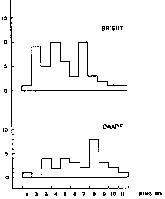


6.1. Luminosity segregation
Zwicky [169] was the first to notice that bright and faint galaxies in Coma have different radial distribution, bright galaxies being more concentrated. His finding was at odd with the conclusion reached by Omer [102] few years before. In the 60's the evidence for luminosity segregation had less supporters (Reaves [109]) than opponents (Abell [4] and Omer [103]), until the new data-set of Rood allowed Rood & Turnrose [116] to conclude that dwarfs are indeed less concentrated than bright galaxies (see Fig. 11). Their results were confirmed by Noonan [101].

|
Figure 11. Bright and dwarf galaxy distributions in concentric rings centered on the Coma cluster centre. The ring no. increases with clustercentric distance - from Rood & Turnrose. |
However, the luminosity segregation in Coma is not a very strong effect. Rood [110] and White [155], [156] noted that a much stronger effect would result from two-body relaxation if all the cluster dark mass was in galaxy halos.
Using the new data-set of Godwin & Peach, Capelato et al.
[23] showed
that luminosity segregation is a more complicated issue than previously
thought. While dynamical friction tends to produce a concentration of brighter
galaxies in the Coma centre, merging of these same galaxies tends to
reduce the
number of intermediate brightness galaxies, and to create
ultra-bright galaxies. Observationally, this effect is seen as an
anti-segregation of galaxies with m25
 14.5.
Capelato et al.'s observational evidence was reproduced in
Roos & Aarseth's numerical simulations only two years later
(see also Athanassoula, these proceedings).
14.5.
Capelato et al.'s observational evidence was reproduced in
Roos & Aarseth's numerical simulations only two years later
(see also Athanassoula, these proceedings).
Thompson & Gregory showed that, among the dwarf galaxies, dwarf ellipticals follow the same distribution of giant ellipticals, while dwarf spheroidals are lacking in the core. This was interpreted as evidence for tidal disruption of the spheroidal galaxies (see also Secker, these proceedings).
Recently, Biviano et al. [16] showed that faint galaxies describe a more regular cluster than do bright galaxies, for which the effect of subclustering is stronger, and interpreted this finding as evidence for ongoing accretion of groups onto the cluster (see also 7 and Lobo, these proceedings).